Francesco de' Rossi, more famously known by the name Francesco Salviati, stands as a pivotal figure in the complex and dazzling tapestry of 16th-century Italian art. Born in Florence in 1510, his life and career spanned a period of immense artistic ferment, witnessing the full flowering of the High Renaissance and the subsequent emergence of Mannerism, a style he would come to master and redefine. His other known aliases include Il Salviati and, particularly in his youth, Cecchino del Salviati, a diminutive perhaps reflecting his early promise or a familiar nickname among peers. Active primarily in Florence, Rome, and with significant sojourns in Venice and France, Salviati's oeuvre is characterized by its sophisticated elegance, intricate compositions, and a brilliant, often daring, use of color. He navigated the demanding worlds of powerful patrons, including cardinals and ducal courts, leaving behind a legacy of frescoes, altarpieces, portraits, and tapestry designs that continue to captivate and intrigue.
Early Life and Florentine Apprenticeships
Francesco de' Rossi was born into a Florence still basking in the artistic glories of Leonardo da Vinci, Michelangelo, and Raphael, though the latter two were by then predominantly based in Rome. His father, Michelangelo de' Rossi, was a humble velvet weaver, and it is not entirely clear what initially propelled young Francesco towards an artistic career. However, the vibrant artistic environment of Florence, with its numerous workshops and ongoing projects, would have provided ample inspiration.
According to Giorgio Vasari, the famed artist and art historian who was also Salviati's close friend and contemporary, Francesco's initial training was somewhat peripatetic. He is said to have spent time in the workshop of Giuliano Bugiardini, a competent painter who had himself been associated with Michelangelo. He also reportedly studied with the sculptor Baccio Bandinelli, a rival of Michelangelo and a significant figure in Florentine art, known for his powerful, if sometimes controversial, sculptural style. This early exposure to sculpture might have contributed to Salviati's strong sense of form and plasticity in his later painted figures.
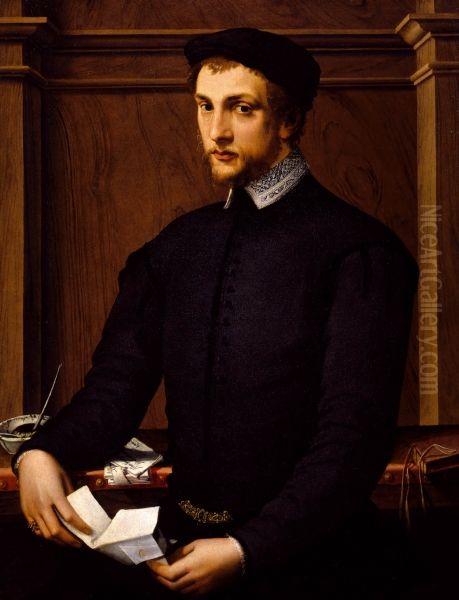
However, the most formative influence during his Florentine youth was undoubtedly Andrea del Sarto. Salviati entered del Sarto's bustling workshop, one of the most prestigious in Florence, around the same time as Giorgio Vasari. Andrea del Sarto, known as "the faultless painter," was celebrated for his harmonious compositions, sfumato technique, and rich, atmospheric color. Working alongside Vasari under del Sarto's tutelage, Salviati would have absorbed the principles of High Renaissance classicism, even as new stylistic currents were beginning to emerge. The friendship forged with Vasari during these years would prove to be lifelong and professionally significant for both artists. Other notable Florentine painters of this era, whose work Salviati would have known, include Pontormo and Rosso Fiorentino, both pioneers of the early Mannerist style, whose expressive elongations and unsettling emotional intensity were already challenging the serene balance of the High Renaissance.
The Roman Crucible and the Salviati Name
In 1531, a pivotal year for the young artist, Francesco de' Rossi moved to Rome. This city, the center of papal power and artistic innovation, was a magnet for ambitious artists. Rome was still reverberating with the impact of Raphael's workshop and Michelangelo's monumental achievements, particularly the Sistine Chapel ceiling. For Salviati, Rome offered a broader artistic horizon and the chance to study both ancient Roman art and the works of the High Renaissance masters at first hand.
It was in Rome that he came under the patronage of Cardinal Giovanni Salviati. The Cardinal, a member of an influential Florentine family with strong ties to the Medici and the papacy, was a significant patron of the arts. Francesco de' Rossi entered his household and, in a common practice of the time, adopted his patron's surname, thereafter becoming known as Francesco Salviati. This association provided him not only with financial support and prestigious commissions but also with access to a sophisticated intellectual and social milieu. It was through Cardinal Salviati that he likely secured some of his early important Roman commissions.
During this first Roman period, Salviati continued to develop his style, absorbing the grandeur of Roman art. He studied the works of Raphael and his followers, such as Giulio Romano and Perino del Vaga, who were themselves pushing the boundaries of Raphael's classicism towards a more dynamic and decorative style. The influence of Michelangelo's powerful figures and complex anatomies also became increasingly apparent in Salviati's work. He also reconnected with Giorgio Vasari, who was also active in Rome, and their artistic dialogue continued. One of Salviati's notable early works from this period is the Annunciation (c. 1533-35) for the church of San Francesco a Ripa, which demonstrates his growing confidence and his ability to synthesize Florentine grace with Roman grandeur. He also painted the Visitation (1538) for the Oratory of San Giovanni Decollato, a work that showcases his elegant figural style and sophisticated compositional skills.
Travels and Broadening Horizons: Venice and Northern Italy
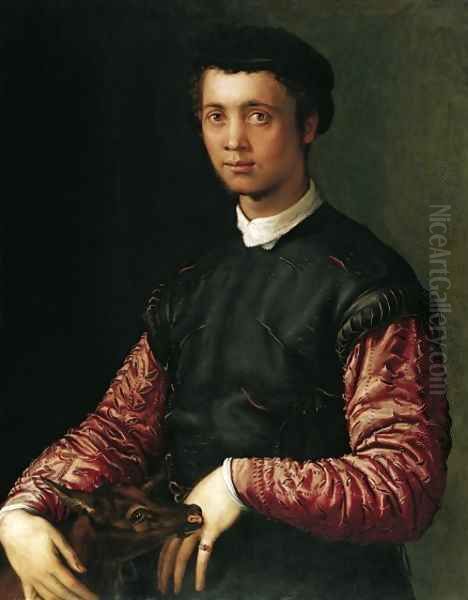
While Rome and Florence remained central to his career, Salviati was not an artist confined to these two cities. His ambition and reputation led him to undertake significant travels, which further enriched his artistic vocabulary. Around 1539, he accompanied Cardinal Giovanni Salviati to Bologna, where he had the opportunity to encounter the works of Parmigianino, another leading light of Mannerism. Parmigianino's supremely elegant, elongated figures, his sophisticated eroticism, and his polished, enamel-like surfaces had a profound impact on Salviati, reinforcing his own inclination towards refined artificiality and intricate design.
From Bologna, Salviati made his way to Venice, the vibrant maritime republic renowned for its unique artistic traditions, particularly its emphasis on color and light. This Venetian sojourn, though relatively brief (1539-1541), was highly significant. He absorbed the lessons of Venetian masters such as Titian, whose mastery of color, texture, and psychological portraiture was unparalleled. While Salviati's fundamental approach remained rooted in Central Italian disegno (drawing and design), his palette visibly brightened, and his handling of paint became richer and more varied after his Venetian experience. He undertook commissions in Venice, including decorations for Palazzo Grimani, where he demonstrated his ability to adapt his style to Venetian tastes while retaining his distinctive Mannerist elegance. The influence of other Venetian painters like Tintoretto, with his dramatic compositions and energetic brushwork, and Paolo Veronese, celebrated for his opulent and luminous scenes, would also have been part of the rich artistic environment he experienced.
Return to Florence: The Triumph of Camillus
In 1543, Salviati returned to his native Florence, now a seasoned artist with a growing reputation. This period marked a high point in his career, particularly with his commission to decorate the Sala dell'Udienza (Audience Hall) in the Palazzo Vecchio, the seat of Florentine government. Duke Cosimo I de' Medici, who was consolidating his power and transforming Florence into a grand ducal capital, was a major patron of the arts, employing artists like Agnolo Bronzino, Vasari, and Benvenuto Cellini to glorify his rule.
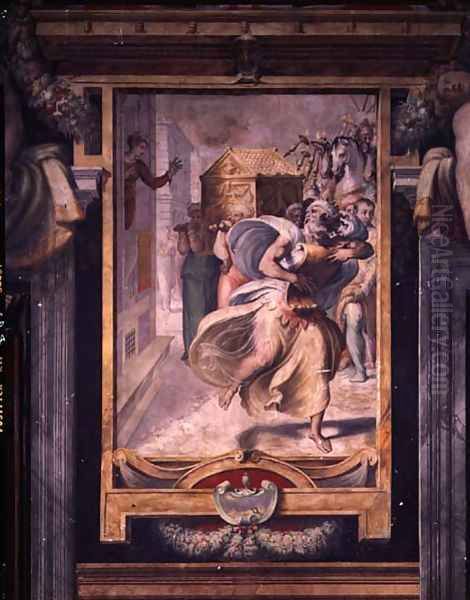
Salviati's frescoes in the Sala dell'Udienza, depicting scenes from the life of the Roman hero Furius Camillus (completed 1543-1545), are a triumph of Mannerist history painting. The Triumph of Camillus is a complex, dynamic composition, filled with muscular figures in elaborate poses, rich architectural settings, and a dazzling array of colors. The frescoes showcase Salviati's mastery of large-scale narrative, his inventive compositions, and his ability to create a sense of opulent grandeur. These works were intended to draw parallels between the ancient Roman Republic's virtues and the strength and wisdom of Duke Cosimo's rule. The Camillus cycle firmly established Salviati as one of the leading painters in Florence, capable of competing with established masters like Bronzino, whose own highly polished and formal style dominated Medicean court portraiture.
During this Florentine period, Salviati also undertook other important commissions, including altarpieces and portraits. His Deposition from the Cross (c. 1547-48), originally for the Dini chapel in Santa Croce and now in the Museo di Santa Croce, is a powerful and emotionally charged work. It combines the anatomical forcefulness reminiscent of Michelangelo with a sophisticated compositional structure and a rich, almost jewel-like, color palette. His portraits from this era, such as the Portrait of a Young Man (Metropolitan Museum of Art, New York), display a keen psychological insight and a meticulous attention to detail in rendering costume and accessories, characteristic of Mannerist portraiture.
The French Interlude: Château de Dampierre
The allure of foreign courts and new opportunities for patronage led Salviati to France in 1554. The French court, particularly under King Francis I (who had died in 1547), had actively recruited Italian artists, most notably Rosso Fiorentino and Francesco Primaticcio, who were instrumental in creating the School of Fontainebleau, a distinctively French iteration of Mannerism. While Salviati did not work directly for the royal court at Fontainebleau, he was invited by Cardinal Charles of Lorraine, a powerful and cultivated prelate, to decorate his Château de Dampierre.
Salviati's time in France, though lasting only until around 1557, allowed him to engage with this Franco-Italian artistic environment. He worked on extensive fresco cycles at Dampierre, though much of this work is now lost or was left unfinished. His presence in France contributed to the ongoing dialogue between Italian and French artistic traditions. The sophisticated, ornamental, and often allegorical nature of the Fontainebleau style, with its emphasis on stucco work combined with painting, would have resonated with Salviati's own decorative sensibilities. His French experience likely further refined his taste for intricate detail and elegant, elongated figural forms. Artists like Niccolò dell'Abate, another Italian who found success in France, were also part of this vibrant cross-cultural exchange.
Later Roman Years and Monumental Fresco Cycles
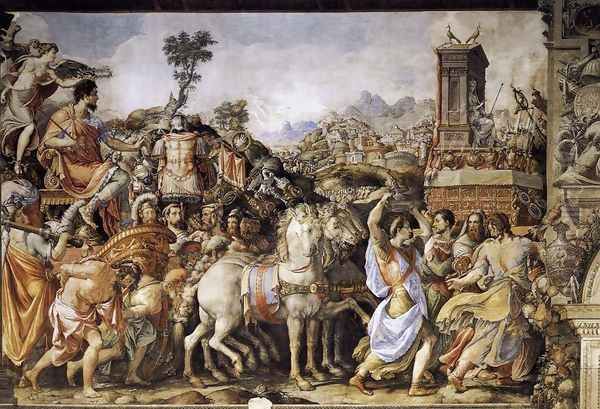
Around 1557, Salviati returned to Rome, which would be his primary base for the remainder of his life. This final Roman period was marked by a series of prestigious and ambitious fresco commissions, cementing his reputation as one of the city's foremost painters. He was a key participant in the decoration of the Palazzo Farnese, one of Rome's grandest Renaissance palaces. Here, he contributed to the Sala dei Fasti Farnesiani (Hall of Farnese Deeds), painting scenes celebrating the history and achievements of the powerful Farnese family, working alongside Taddeo Zuccaro, another prominent Mannerist painter.
Another significant project was the decoration of the Palazzo Sacchetti (then owned by the Ricci family, close associates of the Farnese). Salviati's frescoes here, depicting the Story of David (c. 1553, though some work may have extended into this later period or he returned to it), are characterized by their narrative clarity, dynamic compositions, and rich, vibrant colors. These works demonstrate his mature style, a confident and often dazzling display of Mannerist principles. He also undertook commissions for various Roman churches, including work in San Lorenzo in Damaso and Santa Maria dell'Anima.
Throughout this period, Salviati continued to be a sought-after portraitist. His portraits are noted for their aristocratic elegance, psychological acuity, and the meticulous rendering of luxurious fabrics and intricate details, reflecting the status and sophistication of his sitters. He was also active as a designer of tapestries, a highly valued art form in the 16th century, creating complex allegorical and historical scenes for patrons like Duke Cosimo I de' Medici. These designs, often translated into woven masterpieces by Flemish weavers, further disseminated his inventive style. His contemporaries in Rome included artists like Daniele da Volterra, a follower of Michelangelo, and later, Federico Zuccaro (Taddeo's younger brother), who would continue the Mannerist tradition.
The Quintessence of Salviati's Mannerism
Francesco Salviati's art is a quintessential expression of Mannerism. This style, which emerged after the High Renaissance, was not a rejection of its predecessors but rather an exaggeration and elaboration of their achievements. Salviati's work embodies many of Mannerism's key characteristics:
Complexity and Artificiality: His compositions are often densely packed with figures in intricate, sometimes contorted, poses (the figura serpentinata or serpentine figure was a hallmark). There is a deliberate move away from the naturalism and balanced harmony of the High Renaissance towards a more artificial, self-consciously stylish elegance.
Elongated Proportions: Figures are frequently elongated, with slender limbs and small heads, contributing to an air of grace and sophistication. This was a common trait seen in the works of artists like Parmigianino and Bronzino.
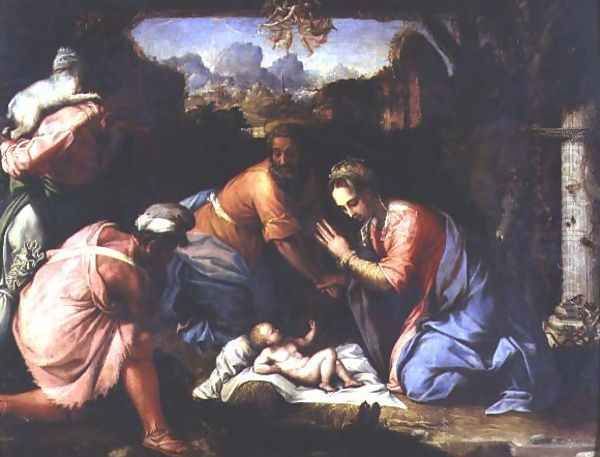
Vibrant and Unconventional Color: Salviati employed a rich and often non-naturalistic color palette. He favored sharp contrasts, iridescent hues, and "shot" colors (cangiante) that shimmer and change, creating a dazzling visual effect.
Emphasis on Disegno: Like most Central Italian artists, Salviati placed a strong emphasis on drawing and design. His works are underpinned by a confident and fluid draughtsmanship, evident in the precise contours and carefully articulated forms.
Intellectual Sophistication: Mannerist art often appealed to a cultivated audience, incorporating complex allegories, obscure mythological references, and intricate symbolism. Salviati's works are no exception, often requiring a degree of erudition to fully appreciate their layered meanings.
Decorative Impulse: There is a strong decorative quality in Salviati's art, seen in the elaborate costumes, ornate architectural settings, and the overall richness of his surfaces. This made his style particularly well-suited for large-scale fresco cycles and tapestry designs.
His ability to synthesize influences from Michelangelo's power, Raphael's grace, Andrea del Sarto's softness, Parmigianino's elegance, and Venetian color into a distinctive personal style made him one of the most versatile and accomplished artists of his generation.
Representative Works and Their Locations
Francesco Salviati's prolific output can be found in major museums and churches across Europe and North America. Some of his most representative works include:
Frescoes of the Life of Furius Camillus (1543-1545): Sala dell'Udienza, Palazzo Vecchio, Florence. This cycle is perhaps his most famous large-scale narrative work.
The Visitation (1538): Oratorio di San Giovanni Decollato, Rome. An early masterpiece showcasing his elegant figural style.
Deposition from the Cross (c. 1547-1548): Museo di Santa Croce, Florence. A powerful and emotionally resonant altarpiece.
Frescoes of the Story of David (c. 1553): Palazzo Sacchetti, Rome. Demonstrating his mature narrative and decorative skills.
Charity (c. 1543-45): Galleria degli Uffizi, Florence. A refined example of his allegorical painting.
Portrait of a Young Man (c. 1540s): The Metropolitan Museum of Art, New York. A characteristic example of his insightful portraiture.
Portrait of a Gentleman with a Letter (c. 1540s): Accademia Carrara, Bergamo.
The Incredulity of Saint Thomas (c. 1543-1547): Musée du Louvre, Paris. A dynamic and complex religious scene.
Annunciation (c. 1533-35): San Francesco a Ripa, Rome.
Justice (c. 1550s): Galleria Borghese, Rome.
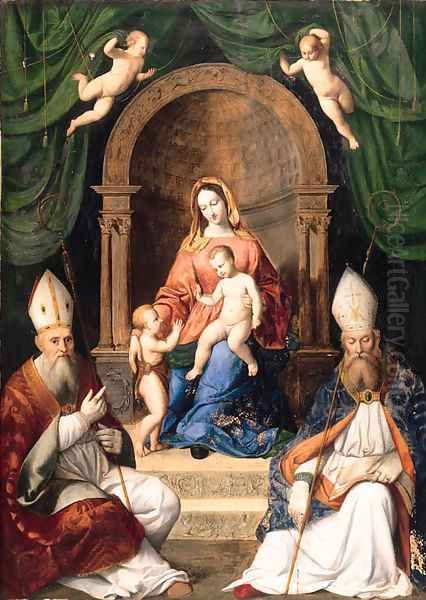
Triumph of Bacchus (drawing): Many of his preparatory drawings, highly valued in their own right, are held in collections like the Uffizi's Gabinetto dei Disegni e delle Stampe and the Louvre.
Other institutions holding his works include the Pinacoteca di Brera in Milan, the Kunsthistorisches Museum in Vienna, the Saint Louis Art Museum, Cornell University's Herbert F. Johnson Museum of Art, and the Alte Pinakothek in Munich.
Legacy and Influence
Francesco Salviati died in Rome in 1563, at the height of his powers. He left behind a significant body of work that had a considerable impact on his contemporaries and subsequent generations of artists, particularly those working within the Mannerist idiom. His sophisticated blend of Florentine disegno and Roman grandeur, enriched by his experiences in Venice and France, made him a truly cosmopolitan artist.
His close friend Giorgio Vasari, in his Lives of the Most Excellent Painters, Sculptors, and Architects, provided a detailed, if sometimes biased, account of Salviati's life and career, ensuring his place in art historical discourse. Salviati's influence can be seen in the work of his pupils and followers, and his elaborate decorative style contributed to the development of later Mannerist and early Baroque decorative schemes. He was a master of complex allegorical programs and large-scale fresco decoration, skills that were highly prized in the courtly and ecclesiastical environments of 16th-century Italy. Artists like Jacopo Zucchi, who may have assisted him, carried forward elements of his intricate and polished style.
Francesco Salviati remains a key figure for understanding the evolution of Italian art in the 16th century. He was an artist of immense talent, ambition, and intellectual capacity, who navigated the shifting artistic currents of his time with remarkable skill and creativity. His works continue to be admired for their technical brilliance, their imaginative power, and their embodiment of the sophisticated and often enigmatic spirit of Mannerism. His legacy is that of an artist who, while deeply rooted in the traditions of the High Renaissance, forged a distinctive and influential path, contributing significantly to one of the most fascinating and complex periods in European art history.